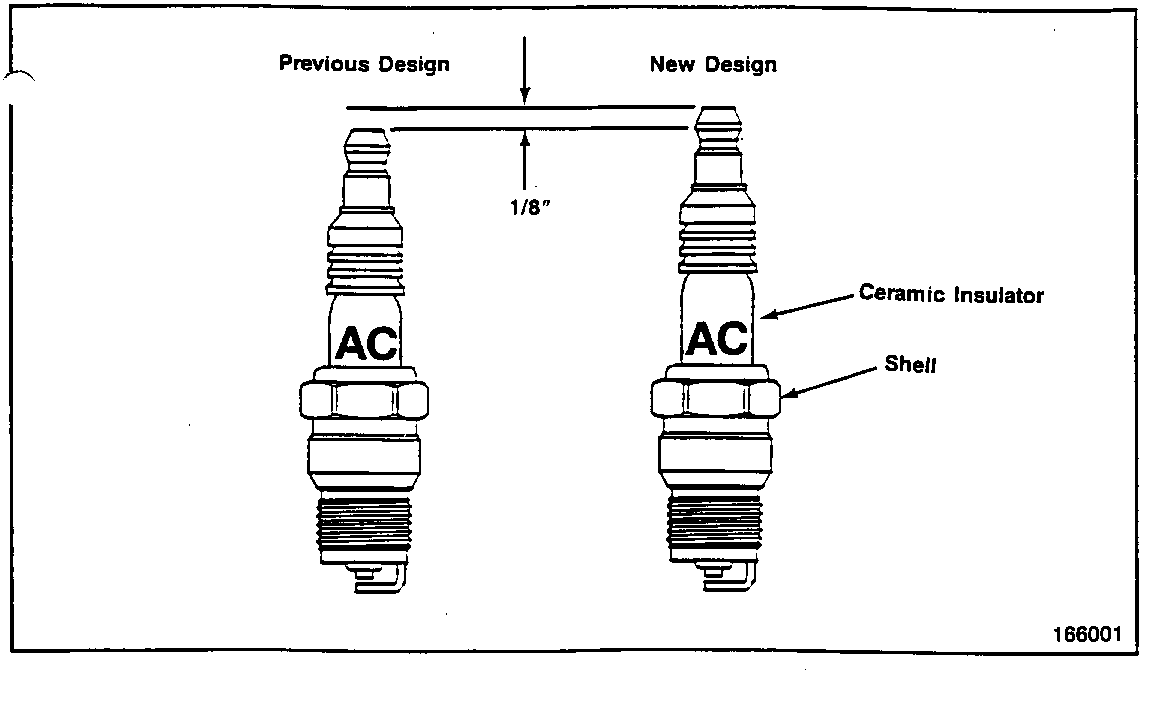NEW DESIGN SPARK PLUGS LONGER CERAMIC INSULATOR

SUBJECT: NEW DESIGN SPARK PLUGS (SERVICE INFORMATION)
VEHICLES AFFECTED: 1991-93 MODELS WITH GASOLINE ENGINES
In 1991 GM introduced a new design spark plug for use in all trucks equipped with gas engines. These new design spark plugs have a ceramic insulator which is approximately 3 mm (1/8 inch) longer than the insulator used in previous model years.
The longer length spark plugs, which conform to S.A.E. and I.S.O. Engineering guidelines, magnify the problem of cracked insulators because currently, most spark plug sockets are not of sufficient length to properly engage the shell hex. If the spark plug shell hex is not fully engaged in the spark plug socket wrench, the socket may cock at an angle and cause insulator cracking and/or breakage during plug installation or removal.
When servicing these new design spark plugs, make sure that the spark plug socket being used is deep enough to accommodate the longer length insulator. The spark plug socket wrench should conform to the proposed S.A.E. and I.S.O. world standards for spark plug socket wrenches. Spark plug socket wrenches that conform to these standards are designed to accept the lengthened spark plugs and allow full engagement of the hex nut on the shell of the spark plug.
Use of a spark plug socket which is NOT deep enough may result in the ceramic insulator becoming cracked above the spark plug shell.
Note: SOME CRACKS IN THE INSULATOR MAY NOT BE VISIBLE. SUCH CRACKS MAY LATER CAUSE A SPARK PLUG TO MISFIRE. SPARK PLUG MISFIRES ARE OFTEN MISDIAGNOSED AS A SLIPPING TRANSMISSION, DEFECTIVE TORQUE CONVERTER CLUTCH, ENGINE IMBALANCE, OR MALFUNCTIONING FUEL SYSTEM.
To prevent insulator damage, it is recommended that the proper spark plug socket wrench be used when removing or replacing spark plugs. one such spark plug socket is the Kent-Moore J-39358 spark plug socket. The tool is available from Kent-Moore. For ordering information call 1-800-GM-TOOLS (1-800-468-6657):
Kent-Moore SPX Corporation 39784 Little Mack Roseville, MI 48066-2298 Fax: 313-774-9870

General Motors bulletins are intended for use by professional technicians, not a "do-it-yourselfer". They are written to inform those technicians of conditions that may occur on some vehicles, or to provide information that could assist in the proper service of a vehicle. Properly trained technicians have the equipment, tools, safety instructions and know-how to do a job properly and safely. If a condition is described, do not assume that the bulletin applies to your vehicle, or that your vehicle will have that condition. See a General Motors dealer servicing your brand of General Motors vehicle for information on whether your vehicle may benefit from the information.
